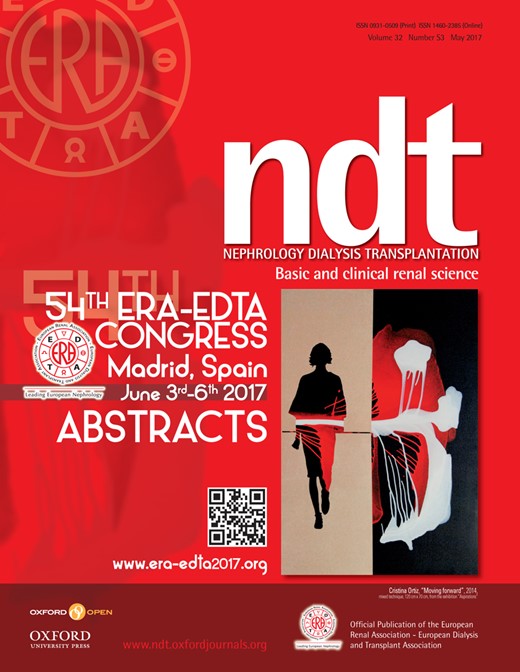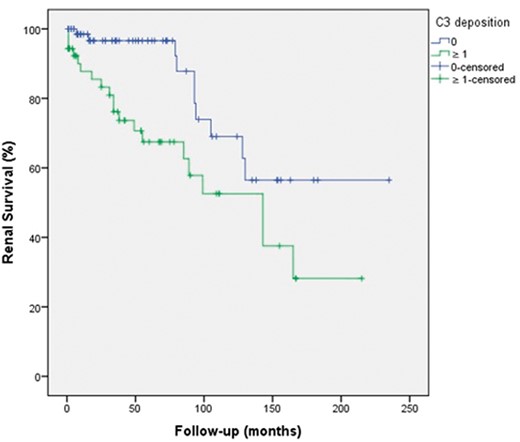-
PDF
- Split View
-
Views
-
Cite
Cite
Safak Mirioglu, Ahmet Dirim, Zulal Istemihan, Arif Akyildiz, Ali Ucar, Yasemin Ozluk, Aydin Turkmen, Yasar Caliskan, SP106
C3 DEPOSITION MAY IMPLICATE DISEASE PROGRESSION IN PATIENTS WITH PRIMARY FOCAL SEGMENTAL GLOMERULOSCLEROSIS, Nephrology Dialysis Transplantation, Volume 32, Issue suppl_3, May 2017, Pages iii140–iii141, https://doi.org/10.1093/ndt/gfx141.SP106Close - Share Icon Share
INTRODUCTION AND AIMS: Focal segmental glomerulosclerosis (FSGS) is one of the most common primary glomerular diseases leading to end stage renal disease. The aim of this study is to evaluate the effects of histopathological, clinical, and laboratory features of patients with primary FSGS on the disease progression.
METHODS: Demographics, clinical characteristics, and renal biopsy findings of 131 patients with primary FSGS and the effects of these features on disease progression were investigated. Of these 131 patients who were followed up for a median duration of 38 (IQR: 12-87) months, 66 (50.4%) were male, and mean age was 36±13 years. Primary outcome was defined as at least a fifty-percent reduction in baseline estimated glomerular filtration rate (eGFR) or initiation of renal replacement therapies. Association of histopathological lesions (percentage of global and segmental sclerosis, presence of crescents and tip lesion, C3 and IgM deposition) and clinical features [age, gender, systolic and diastolic blood pressure (BP), creatinine, hemoglobin, albumin, and proteinuria] with primary outcome was evaluated. eGFRs of patients were calculated with CKD-EPI formula.
RESULTS: Laboratory characteristics of patients at the time of diagnosis were summarized in the table. Renal biopsy specimens contained a median of 15 glomeruli (IQR 10-23). Mean percentage of global and segmental sclerosis were 16.3±17.7 and 15.7±12.4, respectively, and crescents were present in 8 (6.1%) patients. One hundred and twelve (85.5%) and 80 (61.1%) patients received ACEi/ARB and immunosuppressive treatment, respectively. Thirty two (24.4%) patients reached primary outcome. Global and segmental sclerosis were more common in patients who reached primary outcome (25.6% vs 13.3%, p<0.001 and 20.8% vs 14.1%, p=0.007, respectively). Presence of crescents (p=0.374) and tip lesion (p=0.815), use of ACEi/ARB (p=0.173) and immunosuppressive agents (p=0.849) did not differ between patients with and without primary outcome, as well as IgM deposition (p=0.228). However, C3 deposition was significantly more common in patients who reached primary outcome (66.7%) as compared to patients who did not (34.7%, p=0.002). Kaplan-Meier analysis revealed that prognosis of FSGS patients with intense glomerular C3 deposition was quite dismal (p=0.007) (Figure).
SP106 Table Laboratory characteristics of patients at the time of diagnosis.
| Characteristics . | Patients (n=131) (Mean±SD) . |
|---|---|
| Serum creatinine | 1.25±0.7 mg/dL |
| eGFR | 79.3±34.3 ml/min/1.73 m2 |
| Hemoglobin | 13±2.4 g/dL |
| Serum albumin | 3.19±0.94 g/dL |
| Proteinuria | 5.23±3.89 g/day |
| Systolic BP | 133±21 mmHg |
| Diastolic BP | 85±14 mmHg |
| Characteristics . | Patients (n=131) (Mean±SD) . |
|---|---|
| Serum creatinine | 1.25±0.7 mg/dL |
| eGFR | 79.3±34.3 ml/min/1.73 m2 |
| Hemoglobin | 13±2.4 g/dL |
| Serum albumin | 3.19±0.94 g/dL |
| Proteinuria | 5.23±3.89 g/day |
| Systolic BP | 133±21 mmHg |
| Diastolic BP | 85±14 mmHg |
SP106 Table Laboratory characteristics of patients at the time of diagnosis.
| Characteristics . | Patients (n=131) (Mean±SD) . |
|---|---|
| Serum creatinine | 1.25±0.7 mg/dL |
| eGFR | 79.3±34.3 ml/min/1.73 m2 |
| Hemoglobin | 13±2.4 g/dL |
| Serum albumin | 3.19±0.94 g/dL |
| Proteinuria | 5.23±3.89 g/day |
| Systolic BP | 133±21 mmHg |
| Diastolic BP | 85±14 mmHg |
| Characteristics . | Patients (n=131) (Mean±SD) . |
|---|---|
| Serum creatinine | 1.25±0.7 mg/dL |
| eGFR | 79.3±34.3 ml/min/1.73 m2 |
| Hemoglobin | 13±2.4 g/dL |
| Serum albumin | 3.19±0.94 g/dL |
| Proteinuria | 5.23±3.89 g/day |
| Systolic BP | 133±21 mmHg |
| Diastolic BP | 85±14 mmHg |
SP106 Figure






Comments